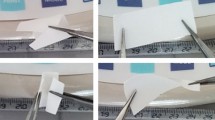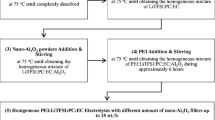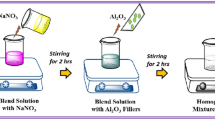Abstract
Ionic conductivity, differential scanning calorimetry (DSC), and 1H nuclear magnetic resonance (NMR) measurements have been performed on (PEO)9Mg(ClO4)2 and (PEO)9Mg(ClO4)2 + Al2O3 (neutral, nanoporous) polymer electrolyte systems. It is observed that the conductivity enhances due to the presence of filler up to 15 wt.% and then decreases. The NMR results are consistent with the idea that the conductivity enhancement is mainly due to the increase in chain mobility and ionic mobility of the solid polymer electrolyte caused by increased amorphocity of the electrolyte due to the presence of filler. DSC results also demonstrate that the fraction of the amorphous phase has increased due to the addition of the filler.
Similar content being viewed by others
Explore related subjects
Discover the latest articles, news and stories from top researchers in related subjects.Avoid common mistakes on your manuscript.
Introduction
Poly(ethylene)oxide (PEO)-based solid polymer electrolytes have received a considerable attention due to their unique mechanical properties, such as high flexibility in combination with stability and the absence of volatile or toxic compounds compared to other polymer electrolytes. The ability of PEO to dissolve salts of divalent cations and monovalent anions was first demonstrated by Blumberg and coworkers in their original studies of PEO–salt solutions formed with HgCl2 and CdCl2 [1]. James and coworkers [2] reported that PEO forms solutions of Zn, Co, Fe, and Co salts. Magnesium ion conducting solid polymer electrolytes have the advantage of low cost and the cells based on these electrolytes have the possibility of using more stable magnesium metal as an electrode material. Several Mg++ ion containing polymer electrolytes have been reported by various groups [3–6].
It has been established that the formation of crystallites in PEO-based systems lowers conductivity at ambient temperature [7, 8]. To overcome this drawback solvating host polymer should be modified to decrease the crystallinity and lower the T g of the polymer electrolyte, while retaining the solvating properties of the ethylene oxide chain. In order to do this, the use of copolymers, formation of cross-linked networks, the addition of plasticizers, and radiation cross-linking has been used [9, 10]. Alternatively, inert fillers such as Al2O3, SiO2, and TiO2 have also been used to increase the ionic conductivity in these polymer electrolytes [11, 12]. These systems are generally known as nanocomposite polymer electrolytes. It has been shown that nanosized ceramic powders, when incorporated into the PEO-based electrolytes, can act as solid plasticizers inhibiting crystallization kinetics and promoting the retention of the amorphous phase down to subambient temperatures [12]. These nanocomposite PEO-based polymer electrolytes have shown enhanced ionic conductivity and improved mechanical and thermal stability [12–15]. Although the established view is that the ionic conductivity in PEO-based electrolytes is higher in the amorphous phase above the glass transition temperature of the polymer electrolyte and that crystalline polymer electrolytes are poor ionic conductors, contradictory results have been published recently by Stoeva et al. [16] and Golodnitsky et al. [17].
Polymers have been studied by nuclear magnetic resonance (NMR) which has resulted in valuable information about their microstructure, such as the conformation and configuration in copolymers, internal motions and relaxation processes, and the nature of the crystalline and amorphous phases [18]. In this work, we have studied the role of alumina fillers in conductivity mechanism in (PEO)9Mg(ClO4)2 polymer electrolyte, with and without alumina filler. The major emphasis of the study is on PEO–Mg salt systems with different weight percentages of Al2O3 as filler. Mg(ClO4)2 salt has been used as the ionic salt to prepare the solid polymer electrolytes. The ionic conductivity, differential scanning calorimetry (DSC), and 1H NMR measurements have been performed on these electrolytes.
Experimental
Sample preparation
PEO (molecular weight, 5 × 106 g mol−1) and Mg (ClO4)2 were purchased from Aldrich. The nanoporous Al2O3 powder (Aldrich) had a pore size 5.8 nm and neutral surface groups. Prior to use, PEO, Mg (ClO4)2, and Al2O3 powder were vacuum dried for 24 h at 40°C, 80°C, and 120°C, respectively. Appropriately weighed quantities of PEO and Mg (ClO4)2 required for PEO to Mg (ClO4)2 ratio of 9:1 were dissolved in anhydrous acetonitrile. Al2O3 powder was added to the above solution which was magnetically stirred at room temperature for at least 24 h, until a homogenous solution was obtained. The amount of filler added varied from 0 to 18.5 wt.% of the total PEO + Mg (ClO4)2 weight. The resulting slurry, after stirring, was cast on to a Teflon plate and then left in order to let the solvent slowly evaporate. After vacuum drying for 24 h, homogenous composite polymer electrolyte films of average thickness 100–200 μm were obtained and stored in a vacuum oven.
AC impedance measurements
Complex impedance measurements were made on disc-shaped samples sandwiched between two stainless steel electrodes of 12.72 mm diameter, using a computer controlled Solatron SI 1260 impedance analyzer in the 20 Hz to 10 MHz frequency range. The temperature of the sample was varied from 30°C to 100°C and the measurements were taken at 10°C intervals on heating. The ionic conductivity was derived from the complex impedance data.
DSC measurements
The melting temperature of samples PEO9Mg (ClO4)2 + 15 wt.% Al2O3 were determined using a Perking Elmer Pyris DSC Instrument. Samples were placed in aluminum DSC pans with a capacity of 40 μl. The measurements were carried out at a heating rate of 10°C/min from −100°C to 20°C using a low temperature cell. A flow of nitrogen gas was maintained over the perforated pan to avoid any contact with atmospheric moisture.
NMR measurements
All NMR experiments were carried out on a Varian Mercury YH 300 spectrometer (300 MHz proton frequency) using PFG Auto 4 probe. NMR measurements were done on solid polymer electrolyte samples prepared as above. 1H NMR spectra were obtained at temperatures between 30°C and 70°C. Spin–spin relaxation time T 2, which directly reflects the degree of mobility of the probing nuclei, was measured using full width at half maximum (FWHM) of the spectra obtained after a 90° pulse of length 25 μs.
Results and discussion
Ionic conductivity
Figure 1 shows ln σ vs. 1/T plots obtained from complex impedance spectra of the PEO9Mg(ClO4)2 + x wt.% Al2O3 system at several Al2O3 concentrations on heating from 25°C to 100°C. The data exhibit an enhancement in conductivity due to the presence of the alumina fillers over the entire temperature range studied. As expected, a discontinuity can be seen in curvature of the curve for the filler-free electrolyte around 60°C. This is due to the melting of PEO crystallites in the complex. The larger conductivity increase observed below ∼50°C is likely to be caused by the conversion of a significant proportion of crystalline polymer into amorphous polymer due to the presence of filler. For the filler-free electrolyte, lower temperatures favor the crystallization of PEO–salt complexes and of unreacted PEO, while the higher temperatures produce a larger fraction of the amorphous phase with higher conductivity. In the crystalline phase, the polymer chains are rigid, and hence, the chain mobility is almost negligible and the conductivity is low. Polymer segments are flexible in the amorphous phase. Ionic motion is facilitated by the flexibility of the polymer chain segments producing a strong coupling between the segmental motion of the polymer and the ionic transport giving rise to a higher conductivity in the amorphous phase.
As depicted in Fig. 1, at each temperature σ increases with increasing Al2O3 content up to 15 wt.% and then decreases considerably. All the conductivity plots of the filler incorporated electrolytes exhibit similar curvature expected for an amorphous electrolyte obeying the Vogel–Tamman–Fulcher (VTF) relation. This suggests that the nanocomposite polymer electrolyte has amorphous structure and the ionic transport takes place by the same mechanism as in the amorphous phase of the filler-free electrolyte.
The variation of ionic conductivity of PEO9Mg(ClO4)2 + x wt.% Al2O3 for five compositions: x = 0, 5, 10, 15, and 18.5 is shown in Fig. 2. From these conductivity isotherms, it is clear that, at a given temperature, the conductivity increases with increasing alumina content up to 15 wt.% and then decreases considerably. According to the ideas proposed by several previous workers [12–15], the composite polymer electrolyte system at low filler concentrations may be imagined as a conducting medium where filler grains are randomly and uniformly distributed throughout the volume. The presence of the filler grains could give rise to additional favorable conducting pathways in the vicinity of the surface of the grains. The number of such additional high conducting pathways is expected to increase with increasing filler surface area. At low enough filler concentrations, where the grains are still well separated, these surface interactions can account for the observed conductivity increase with increasing filler concentration. An additional contribution to the observed conductivity enhancement could come from the increased amorphous nature of the polymer electrolyte due to the presence of the filler at low concentrations. As suggested by several previous workers, the presence of a low concentration of alumina fillers appears to favor the retention of the amorphous phase of the electrolyte.
The decrease of conductivity at filler concentrations higher than 15 wt.% is evidently due to the locking effect of the geometric constrictions imposed by the more abundant highly resistive alumina grains. This makes the long-chain polymer chains more “immobilized” giving rise to a restricted segmental motion and a lower conductivity.
A maximum value of ionic conductivity for 15 wt.% Al2O3 composition imply that the filler has increased also the carrier concentration of lithium ions as suggested by Croce et al. [12, 15]. Increased carrier concentration would also increase the ionic conductivity. Although we have no T g data for compositions greater than 15 wt.% Al2O3, studies on PEO9:Cu(CF3SO3)2 incorporating Al2O3 grains have shown that the maximum conductivity composition correspond to the minimum T g composition [19, 20].
DSC results
DSC thermograms for the samples PEO9Mg(ClO4)2 and PEO9Mg(ClO4)2 + 15 wt.% of Al2O3 are shown in Fig. 3. According to Fig. 3, apparent phase transitions have been observed at −50.2°C and −58.4°C, respectively, for PEO9Mg(ClO4)2 and PEO9Mg(ClO4)2 + 15 wt.% of Al2O3. This indicates that the addition of the filler has reduced the glass transition temperature of the polymer and increased the more conducting amorphous phase.
1H NMR
1H NMR measurements of samples PEO9Mg(ClO4)2 and PEO9Mg(ClO4)2 + x wt.% Al2O3, x = 0,5, 10, 15, and 18.5 were taken on heating from 30°C to 70°C. The variation of full width at half maximum with temperature is shown in Fig. 4.
In solids, randomly oriented magnetic dipoles create magnetic fields called local magnetic fields. These magnetic fields vary from site to site within the lattice and increase the distribution of resonance frequency and line width. In liquids, magnetic field is homogeneous and gives sharp peaks due to small variation in the energy levels. According to Fig. 4, FWHM decreases with increasing temperature, i.e., NMR peaks get narrower indicating that the solid properties of the polymer electrolyte decrease due to decrease in crystalline phase and increase in the amorphous phase. These curves correlate well with ln σ vs. 1/T curves depicted in Fig. 1, suggesting that the conductivity increase due to increase in temperature as well as due to presence of filler comes mostly from the increased amorphous phase in the material.
The spin–spin relaxation time T 2 is inversely proportional to FWHM. Higher T 2 value in general reflects a higher mobility of the probing species. In this work, the probing nuclei are protons (1H) bound to the polymer chain. Therefore, any change in the mobility of 1H directly indicates a similar change in the mobility of the polymer chains. As it can be extracted from Fig. 4, T 2 increases with weight percent of Al2O3 up to 15 wt.% and then decreases, indicating that the highest polymer segmental mobility in the polymer electrolyte is observed at 15 wt.% of Al2O3. In order to fulfil the aim of this work, it is sufficient to investigate the trend of T 2. However, precise values of spin–spin relaxation time can be obtained by using other NMR methods [21].
T 2 depends on the motion of the nuclei in the polymer electrolyte. Increase in temperature of the polymer melt increases the mobility of polymer segments due to increased amorphocity and hence increases T 2. A similar effect is caused by the presence of alumina filler up to 15 wt.%. Beyond this alumina composition, T 2 decreases as the high concentration of filler material restricts polymer segmental motion, as described earlier.
The results from the 1H NMR measurements on the polymer electrolyte are consistent with the results of the DSC and conductivity measurements and suggest that the ionic conductivity increases due to the presence of the alumina filler up to 15 wt.% composition mainly due to the increased amorphous phase. Beyond this filler concentration, the conductivity drops, possibly due to restrictions imposed on chain segmental mobility by the presence of higher concentration of filler material.
The above interpretation, however, cannot explain fully the conductivity enhancement due to the filler observed in the amorphous phase in the electrolyte at temperatures above the PEO crystallite melting temperature of ∼60°C, because the electrolyte is already in the amorphous state at these temperatures. As suggested by previous workers, surface interactions, most likely through the formation of Lewis acid–base type transient bonding of migrating ionic species with O and OH surface groups on filler grains, could possibly be responsible for this conductivity enhancement [12–14, 20]. The presence of filler grains could give rise to additional transient sites for ionic migration, in addition to promoting an amorphous phase that allows polymer chains more dynamic, thus providing favorable conducting pathways for migrating species. This can contribute to the ionic conductivity enhancement in the amorphous phase.
Several PEO-based polymer electrolytes incorporating nanosize fillers such as Al2O3, SiO2, and TiO2 have demonstrated convincingly that the conductivity enhancement is due to one or more of the following processes:
-
(a)
The availability of additional transient hopping sites at O and off surface groups on alumina through Lewis acid–base type of bonding
-
(b)
The increase in carrier concentration due to the presence of the filler
-
(c)
The increase of the fraction of the high conducting amorphous phase caused by the filler at low filler concentration
In the present system, it appears that all those three mechanisms contribute to the observed conductivity enhancement as evident by ionic conductivity, DSC, and NMR data.
Conclusions
For the PEO9Mg(ClO4)2, according to the DSC results, the exothermic peak shifts from −50.2°C to −58.4°C indicating that the glass transition temperature of the polymer electrolyte has decreased by addition of Al2O3. This indicates that due to the presence of Al2O3, the amorphocity of the material has increased.
The 1H NMR spin–spin relaxation time T 2 has increased up to 15 wt.% of Al2O3 and then decreased. This is attributed to increase in the segmental mobility of the polymer chains, due to increase of the amorphocity. As the mobility of the chain segments within amorphous phase is higher than that in the crystalline phase, these provide additional experimental evidences for the enhancement of ionic conductivity associated with the increased amorphous phase of the polymer electrolyte due to addition of filler. At higher filler concentrations, physical constrictions restrict chain mobility resulting in a decrease in T 2 and hence a decrease in conductivity.
Additional major contributions to ionic conducting enhancement due to the filler, at temperatures above ∼60°C, where the electrolyte is already in its amorphous phase, is likely to come also from possible Lewis acid–base type transient bonding between migrating ionic species and O and OH surface groups on alumina grains and also from an increase in carrier concentration caused by the presence of filler grains.
References
Blumberg AA, Pollack SS, Hoere CAJ (1964) J Polym Sci Part Polym Chem 2:2499
James DB, Wetton RE, Brown DS (1979) Polym J 20:187. doi:10.1016/0032-3861(79)90220-9
Perera K, Dissanayake MAKL, Bandaranayake PWSK (2004) Mater Res Bull 39:1745. doi:10.1016/j.materresbull.2004.03.027
Liebenow C (1998) Electrochim Acta 43:1235. doi:10.1016/S0013-4686(97)10026-3
Kumar GG, Munichandraih N (2000) Solid State Ion 128:203. doi:10.1016/S0167-2738(00)00276-9
Reddy MJ, Chu PP (2002) J Power Sources 109:340. doi:10.1016/S0378-7753(02)00084-8
Armand M, Chabagno JM, Duclot M (1979) Fast ion transport in solids. North Holland, New York
Mac Callum JR, Vincent CA (1987) Polymer electrolyte reviews. Elsevier, London
Gray FM (1997) In: “Polymer electrolytes”. Royal Soc Chem Materials Monographs, Cambridge
Tsunemi K, Ohno H, Tsuchida E (1983) Electrochim Acta 28:833. doi:10.1016/0013-4686(83)85155-X
Weston JE, Steele BCJ (1982) Solid State Ion 7:75. doi:10.1016/0167-2738(82)90072-8
Croce F, Appetechchi GB, Persi L, Scrosati B (1998) Nature 394:456. doi:10.1038/28818
Marcinek M, Bac A, Lipka P, Zaleska A, Zukowska G, Borkowska R, Wieczorek W (2000) J Phys Chem B 104:11088. doi:10.1021/jp0021493
Dissanayake MAKL, Jayathilaka PARD, Bokalawala RSP, Albinsson I, Mellander BE (2003) J Power Sources 119–121:409. doi:10.1016/S0378-7753(03)00262-3
Croce F, Persi L, Scrosati B, Serraino-Fiory F, Plichta E, Hendrickson MA (2001) Electrochim Acta 46:2457. doi:10.1016/S0013-4686(01)00458-3
Stoeva Z, Martin-Litas I, Staunton E, Andreev YG, Bruce PG (2003) J Am Chem Soc 125:4619. doi:10.1021/ja029326t
Golodnitsky D, Livshits E, Ulus A, Peled E (2002) Polym Adv Technol 13:683. doi:10.1002/pat.266
Chung SH, Wang Y, Persi L, Croce F, Greenbaum SG, Scrosati B, Plichta E (2001) J Power Sources 97–98:644. doi:10.1016/S0378-7753(01)00748-0
Jayathilaka PARD, Dissanayake MAKL, Albinsson I, Mellander BE (2002) Electrochim Acta 47:3257. doi:10.1016/S0013-4686(02)00243-8
Jayathilaka PARD, Bokalawela RSP, Bandaranayake PWSK, Bandara LRAK, Dissanayake MAKL (2003) Solid state ionics: trends in new millennium. World Scientific, Singapore, pp 337–343
Freibolin H (1993) Basic one and two dimensional NMR spectroscopy. VCH, Weinheim
Acknowledgments
W.D.D. Wijesiri is acknowledged for her help during this work. Authors wish to thank the International Programmes in the Physical Sciences (IPPS), Uppsala University, Sweden for research support.
Author information
Authors and Affiliations
Corresponding author
Rights and permissions
About this article
Cite this article
Ekanayake, P., Dissanayake, M.A.K.L. Effect of nanoporous alumina filler on conductivity enhancement in PEO9(MgClO4)2 polymer electrolyte: a 1H NMR study. J Solid State Electrochem 13, 1825–1829 (2009). https://doi.org/10.1007/s10008-008-0768-z
Received:
Revised:
Accepted:
Published:
Issue Date:
DOI: https://doi.org/10.1007/s10008-008-0768-z








